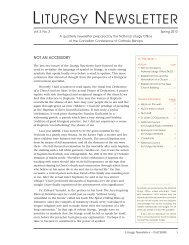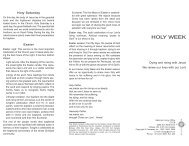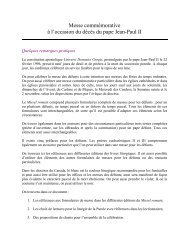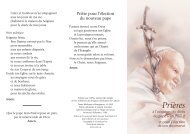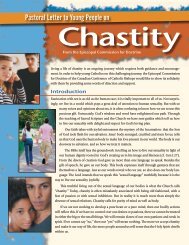Popular Piety in Canada
Popular Piety in Canada
Popular Piety in Canada
You also want an ePaper? Increase the reach of your titles
YUMPU automatically turns print PDFs into web optimized ePapers that Google loves.
<strong>Popular</strong> <strong>Piety</strong><br />
<strong>in</strong> <strong>Canada</strong><br />
Reflections on<br />
some popular<br />
expressions<br />
of the faith<br />
by the Commission for Doctr<strong>in</strong>e of the Canadian Conference of Catholic Bishops<br />
© Photos.com<br />
INTRODUCTION<br />
The unprecedented event of the visit to <strong>Canada</strong><br />
of the relics of Sa<strong>in</strong>t Thérèse of Lisieux <strong>in</strong> 2001<br />
brought about a spontaneous outpour<strong>in</strong>g of<br />
popular devotion. As well, the pilgrimage of the World<br />
Youth Day cross that journeyed across <strong>Canada</strong> by air,<br />
boat, tra<strong>in</strong>, truck and dogsled, which culm<strong>in</strong>ated <strong>in</strong><br />
Pope John Paul II’s visit to Toronto <strong>in</strong> the summer of<br />
2002, occasioned an impressive degree of fervour and<br />
enthusiasm among <strong>Canada</strong>’s youth. More recently, the<br />
pilgrimage of the Ark of the New Covenant served <strong>in</strong> a<br />
similar manner to raise enthusiasm among the faithful<br />
around the 2008 International Eucharistic Congress<br />
<strong>in</strong> Quebec, as did the canonization of Brother André.<br />
In keep<strong>in</strong>g with the spirit of these remarkable<br />
manifestations which served as authentic experiences<br />
of Christian faith for the one and a half million<br />
participants <strong>in</strong> the various events, the Commission<br />
for Doctr<strong>in</strong>e of the Canadian Conference of Catholic<br />
Bishops (CCCB) wishes to re-exam<strong>in</strong>e the importance<br />
and the role of popular piety <strong>in</strong> <strong>Canada</strong>. We will rely<br />
on the results of a survey that was undertaken several<br />
years ago regard<strong>in</strong>g the pr<strong>in</strong>cipal expressions and<br />
practices of popular devotion with<strong>in</strong> the Catholic<br />
dioceses of <strong>Canada</strong>. We will also present theological<br />
references from the Directory on <strong>Popular</strong> <strong>Piety</strong> and the<br />
Liturgy promulgated <strong>in</strong> 2001 by the Congregation for<br />
Div<strong>in</strong>e Worship and the Discipl<strong>in</strong>e of the Sacraments.<br />
F<strong>in</strong>ally, this document will offer a broad picture<br />
of popular piety <strong>in</strong> <strong>Canada</strong>, identify<strong>in</strong>g the most<br />
significant aspects from the theological po<strong>in</strong>t of view,<br />
and will propose certa<strong>in</strong> guidel<strong>in</strong>es.<br />
POPULAR EXPRESSIONS<br />
OF FAITH IN CANADA<br />
Several years ago the Theology Commission, now the<br />
Commission for Doctr<strong>in</strong>e, conducted a survey of the<br />
major expressions of popular devotion throughout<br />
<strong>Canada</strong>, to which the response was both impressive<br />
and reveal<strong>in</strong>g. The current Commission for Doctr<strong>in</strong>e<br />
would like to sketch a composite profile of the popular<br />
piety that emerged from this survey.<br />
When look<strong>in</strong>g at the overall picture of popular<br />
piety <strong>in</strong> <strong>Canada</strong>, the follow<strong>in</strong>g salient features emerge:
angels, and the entire communion of sa<strong>in</strong>ts <strong>in</strong> heaven<br />
are <strong>in</strong>deed present and united to the faithful <strong>in</strong> the<br />
family of God, the Church. When believers venerate<br />
icons, they enter a sacred time and space and are led<br />
to communion with the mystery signified. The faithful<br />
rema<strong>in</strong> attached – and deeply so – to the sacred images,<br />
icons, statues and crosses with which they adorn their<br />
homes or wear on their persons. The personal use of<br />
these is of major assistance <strong>in</strong> help<strong>in</strong>g them encounter<br />
the mystery of the Christian faith <strong>in</strong> their daily lives.<br />
2 Central among the popular devotions <strong>in</strong> <strong>Canada</strong><br />
is Eucharistic adoration. Eucharistic devotion refers to<br />
the worship of the Blessed Sacrament outside of the<br />
celebration of Mass. These <strong>in</strong>clude visits to the Blessed<br />
Sacrament, processions on the Feast of Corpus Christi,<br />
exposition of the Blessed Sacrament and the Forty<br />
Hours devotion.<br />
Photo: LovesMacs<br />
1 <strong>Popular</strong> piety is highly valued and promoted <strong>in</strong><br />
a multitude of ways among both Lat<strong>in</strong> and Eastern<br />
Catholics here <strong>in</strong> <strong>Canada</strong>. Not only is there evidence<br />
that the faithful spontaneously assign considerable<br />
spiritual value to practices of popular devotion, these<br />
devotions are actively encouraged throughout the year<br />
(e.g., on feast days). The many shr<strong>in</strong>es, sanctuaries,<br />
processions, organized pilgrimages, as well as the<br />
numerous relics and icons venerated <strong>in</strong> <strong>Canada</strong> bear<br />
witness to the popular devotion of the faithful. If the<br />
number of major shr<strong>in</strong>es <strong>in</strong> <strong>Canada</strong> is impressive, so<br />
too is the number of small active local shr<strong>in</strong>es, outdoor<br />
grottos and sanctuaries <strong>in</strong> virtually every diocese. The<br />
Novalis Guide to Canadian Shr<strong>in</strong>es lists no fewer than<br />
177 such popular sites of devotion across <strong>Canada</strong>. The<br />
Stations of the Cross and cross-carry<strong>in</strong>g pilgrimages are<br />
also popular <strong>in</strong> many parishes, especially dur<strong>in</strong>g the<br />
Paschal Triduum.<br />
For Eastern Christians especially, the veneration<br />
of holy icons is very significant. Icons are called holy<br />
because they are channels of div<strong>in</strong>e light, grace and<br />
beauty, “images of the <strong>in</strong>visible,” <strong>in</strong>struments that<br />
portray and testify that the Most Holy Tr<strong>in</strong>ity, the<br />
3 To a remarkable extent, popular piety <strong>in</strong> <strong>Canada</strong><br />
co<strong>in</strong>cides with the Church’s liturgical calendar and feast<br />
days. With few exceptions, the majority of popular<br />
devotions <strong>in</strong> <strong>Canada</strong> take place <strong>in</strong> conjunction with the<br />
concomitant feast day or season of the liturgical year.<br />
Div<strong>in</strong>e Mercy Sunday and the solemnities of Corpus<br />
Christi and the Sacred Heart of Jesus are especially<br />
surrounded with popular devotions, processions and<br />
expressions of adoration. In a great many dioceses,<br />
novenas are offered at various shr<strong>in</strong>es of Our Lady to<br />
co<strong>in</strong>cide with the Assumption of the Blessed Virg<strong>in</strong><br />
Mary (August 15 th ) and the feast of Our Lady of the<br />
Holy Rosary (October 7 th ), while special devotions<br />
are held on the feast of St. Anne (July 26 th ). Churches<br />
of the Byzant<strong>in</strong>e tradition, <strong>in</strong>clud<strong>in</strong>g the members of<br />
the Ukra<strong>in</strong>ian Catholic community, conduct a Great<br />
Bless<strong>in</strong>g of Water service on the feast of the Theophany<br />
(January 6 th /19 th ), commemorat<strong>in</strong>g Christ’s baptism <strong>in</strong><br />
the Jordan River by John the Baptist. In some areas,<br />
this service is conducted alongside a river, after which<br />
the blessed water is distributed among the faithful, who<br />
take it to their homes.<br />
Special devotions also take place <strong>in</strong> most parishes<br />
across the country on the feast of the patron sa<strong>in</strong>t of the<br />
parish church: holy hours, novenas, triduums, even<strong>in</strong>g<br />
prayer, the recitation of the rosary, adoration of the<br />
Blessed Sacrament and the “moleben” prayer service<br />
<strong>in</strong> the Eastern Catholic Churches. These popular<br />
expressions of faith co<strong>in</strong>cide with the liturgical calendar,<br />
2
eflect<strong>in</strong>g the teach<strong>in</strong>g of Vatican II’s Constitution<br />
Sacrosanctum Concilium: “Such devotions should be<br />
so drawn up that they harmonize with the liturgical<br />
seasons, accord with the sacred Liturgy, are <strong>in</strong> some<br />
way derived from it, and lead the people to it, s<strong>in</strong>ce<br />
<strong>in</strong> fact the Liturgy by its very nature far surpasses any<br />
of them.” 1 We can be grateful for this, s<strong>in</strong>ce history<br />
has shown that whenever the faithful lose sight of<br />
the values essential to the Liturgy itself, the correct<br />
relationship between Liturgy and popular piety beg<strong>in</strong>s<br />
to be distorted.<br />
4 The most fervent and popular expressions of faith<br />
<strong>in</strong> <strong>Canada</strong> are reserved for the Blessed Virg<strong>in</strong> Mary<br />
and St. Anne. It would not be an exaggeration to say<br />
that the popular piety of the faithful <strong>in</strong> <strong>Canada</strong> has<br />
a dist<strong>in</strong>ctive fem<strong>in</strong><strong>in</strong>e quality. The maternity and<br />
maternal qualities of both Our Lady and St. Anne strike<br />
a chord <strong>in</strong> the hearts of Canadians, particularly among<br />
Indigenous peoples. This should come as no surprise,<br />
given the pioneer<strong>in</strong>g role of so many heroic women<br />
<strong>in</strong> the found<strong>in</strong>g years of <strong>Canada</strong> as a young nation.<br />
The remarkable contribution made over the years by so<br />
many religious women <strong>in</strong> establish<strong>in</strong>g Catholic schools,<br />
hospitals, and charitable agencies is deeply embedded<br />
<strong>in</strong> the collective memory and culture of our people.<br />
Photo: Nova Development<br />
Closely associated with this pre-em<strong>in</strong>ent devotion <strong>in</strong><br />
every diocese accorded to the Blessed Virg<strong>in</strong> Mary, we<br />
f<strong>in</strong>d evidence <strong>in</strong> several regions of a deep and fervent<br />
attachment to Sa<strong>in</strong>t Joseph and the Holy Family. In<br />
<strong>Canada</strong>, these devotions are also historically marked by<br />
a strong cultural sense of family life.<br />
5 The popular piety of the faithful <strong>in</strong> <strong>Canada</strong> is<br />
also noted for its dist<strong>in</strong>ctive Canadian character and<br />
roots. “<strong>Popular</strong> piety is naturally marked by historical<br />
and cultural factors.” 2 Our survey <strong>in</strong>dicated that the<br />
faithful have a special devotion to Canadian sa<strong>in</strong>ts and<br />
blesseds. If hol<strong>in</strong>ess, like charity, beg<strong>in</strong>s “at home”, the<br />
popular devotion of the faithful therefore reserves a<br />
special place of honour and veneration for <strong>Canada</strong>’s own<br />
holy men and women. The follow<strong>in</strong>g enjoy a special<br />
place <strong>in</strong> the devotion and hearts of the faithful: the<br />
Canadian Martyrs, Marguerite Bourgeoys, Marguerite<br />
d’Youville, Brother André, Bishop Nykyta Budka,<br />
Bishop Vasyl Velychkovsky, Kateri Tekakwitha, Bishop<br />
Laval, Mary of the Incarnation, and Rose Pr<strong>in</strong>ce of the<br />
Carrier Nation. These and many more are celebrated<br />
at various historical sites and shr<strong>in</strong>es <strong>in</strong> <strong>Canada</strong><br />
with great devotion. It is as though these venerated<br />
Canadian <strong>in</strong>dividuals are perceived as hav<strong>in</strong>g a special<br />
Photo: Nova Development<br />
1 Sacrosanctum Concilium 13. Cf also the Directory on<br />
<strong>Popular</strong> <strong>Piety</strong> and the Liturgy 46, 48, 50, 58.<br />
2 Directory on <strong>Popular</strong> <strong>Piety</strong> and the Liturgy 91. The Directory<br />
also rem<strong>in</strong>ds us that “popular piety is the first and most<br />
fundamental form of the faith’s <strong>in</strong>culturation.” (91)<br />
3
“familial” aff<strong>in</strong>ity; they are <strong>in</strong>voked as our very own.<br />
As the Pontifical Council for Culture states, “<strong>Popular</strong><br />
piety rema<strong>in</strong>s one of the best examples of genu<strong>in</strong>e<br />
<strong>in</strong>culturation of faith, because it is a harmonious<br />
blend of faith and Liturgy, feel<strong>in</strong>gs and art, and the<br />
recognition of our identity <strong>in</strong> local traditions.” 3<br />
POINTS FOR<br />
FURTHER REFLECTION<br />
The Second Vatican Council declared <strong>in</strong> its Constitution<br />
on the Sacred Liturgy Sacrosanctum Concilium:<br />
“<strong>Popular</strong> devotions of the Christian people are to be<br />
highly commended, provided they accord with the<br />
laws and norms of the Church, above all when they are<br />
ordered by the Apostolic See…. But these devotions<br />
should be so drawn up that they harmonize with the<br />
liturgical seasons, accord with the sacred Liturgy, are<br />
<strong>in</strong> some fashion derived from it, and lead the people<br />
to it, s<strong>in</strong>ce, <strong>in</strong> fact, the Liturgy by its very nature far<br />
surpasses any of them” (no. 13).<br />
Accord<strong>in</strong>g to the Catechism of the Catholic Church,<br />
“Besides sacramental Liturgy and sacramentals,<br />
catechesis must take <strong>in</strong>to account the forms of piety<br />
and popular devotions among the faithful. The<br />
religious sense of the Christian people has always found<br />
expression <strong>in</strong> various forms of piety surround<strong>in</strong>g the<br />
Church’s sacramental life, such as the veneration of<br />
relics, visits to sanctuaries, pilgrimages, processions,<br />
the Stations of the cross, religious dances, the rosary,<br />
medals, etc.” (no. 1674). The Catechism adds that<br />
“these expressions of piety extend the liturgical life of<br />
the Church, but do not replace it” (no. 1675).<br />
The Congregation for Div<strong>in</strong>e Worship and the<br />
Discipl<strong>in</strong>e of the Sacraments published the Directory<br />
on <strong>Popular</strong> <strong>Piety</strong> and the Liturgy <strong>in</strong> December 2001,<br />
<strong>in</strong> order to affirm the primacy of the Liturgy and to<br />
cultivate a positive and encourag<strong>in</strong>g stance toward<br />
popular piety. It seeks to offer guidel<strong>in</strong>es to ensure<br />
“a balanced relationship between various forms of<br />
popular piety and the Church’s Liturgy.” 4 Follow<strong>in</strong>g<br />
the release of this document, the Bishops of <strong>Canada</strong><br />
were consulted at the level of their national Conference<br />
regard<strong>in</strong>g ways <strong>in</strong> which it could be implemented.<br />
This Roman document constitutes a reference tool<br />
for the Bishops, specifically with<strong>in</strong> the context of the<br />
visit of the relics of Sa<strong>in</strong>t John Bosco, but also to revive<br />
recognition for all pilgrimages <strong>in</strong> various regions across<br />
the country that rema<strong>in</strong> unknown to the faithful.<br />
The Directory highlights the connections between<br />
the Liturgy and popular piety and establishes some<br />
excellent guidel<strong>in</strong>es to ensure that the organic l<strong>in</strong>k<br />
between the Liturgy and popular expressions of the<br />
faith is never ignored or severed. Chapter III (nos. 76-<br />
92) of the Directory outl<strong>in</strong>es the theological pr<strong>in</strong>ciples<br />
for an evaluation and renewal of popular piety. These<br />
can be very useful as guidel<strong>in</strong>es for any diocesan or<br />
parish formation program that seeks to foster an even<br />
greater harmony and correct relationship between<br />
popular devotions and the Church’s div<strong>in</strong>e worship.<br />
What follows is a summary of these guidel<strong>in</strong>es. The<br />
bold numbers <strong>in</strong> brackets refer to the specific section as<br />
found <strong>in</strong> the Directory.<br />
• Reference to the Most Blessed Tr<strong>in</strong>ity, while<br />
sem<strong>in</strong>ally present <strong>in</strong> popular piety, is an element<br />
requir<strong>in</strong>g further emphasis. Christian prayer<br />
is always directed to the Father, through the<br />
mediation of the Son, <strong>in</strong> the power of the Holy<br />
Spirit. Christian prayer without any reference to<br />
the Blessed Tr<strong>in</strong>ity is unth<strong>in</strong>kable. [79, 80]<br />
© Photos.com<br />
3 Pontifical Council for Culture, Towards a Pastoral Approach<br />
to Culture (23 May, 1999) 28.<br />
4 Murray J. Kroetsch, “Revisit<strong>in</strong>g <strong>Popular</strong> <strong>Piety</strong> and Devotions:<br />
The Perspective from the Directory on <strong>Popular</strong> <strong>Piety</strong><br />
and the Liturgy,” National Bullet<strong>in</strong> on Liturgy 37:179<br />
(2004): 203.<br />
4
Photo: Jeffrey Williams, Dreamstime<br />
• <strong>Popular</strong> piety should give greater emphasis to the<br />
person and action of the Holy Spirit. Authentic<br />
forms of popular piety are the fruits of the Holy<br />
Spirit and must always be regarded as expressions<br />
of the Church’s piety. Every true form of piety<br />
comes from the Spirit and is exercised <strong>in</strong> the Spirit.<br />
[78, 80, 87]<br />
• It is also necessary for popular piety to emphasize<br />
the fundamental importance of the Resurrection of<br />
Christ. Devotions directed to the suffer<strong>in</strong>g of Christ<br />
and the Via Crucis should also <strong>in</strong>clude reference to<br />
his glorification so as to give <strong>in</strong>tegral expression to<br />
the Paschal mystery. The heart of this mystery is<br />
Christ’s victory over death, as the one who was dead<br />
but now lives forever (cf. Rev 1:18). [80]<br />
• Devotion to the Passion of Christ should also lead<br />
the faithful to a full and conscious participation <strong>in</strong><br />
the Eucharist. [80] In this connection, we do well to<br />
remember that Eucharistic adoration may ord<strong>in</strong>arily<br />
take place only where the Blessed Sacrament is<br />
reserved, and that the Blessed Sacrament can only be<br />
reserved <strong>in</strong> a church or chapel where the celebration<br />
of the Holy Eucharist takes place.<br />
• In vary<strong>in</strong>g degrees and ways, popular piety should<br />
give expression to the “ecclesial” pr<strong>in</strong>ciple, <strong>in</strong> virtue<br />
of which the faithful are constituted the holy People<br />
of God. For example, the veneration of the Blessed<br />
Virg<strong>in</strong> Mary, of the Angels and Sa<strong>in</strong>ts, and prayer<br />
for the dead, should be set <strong>in</strong> the larger context of<br />
the Communion of the Sa<strong>in</strong>ts, that vital relationship<br />
exist<strong>in</strong>g between the heavenly Church and the<br />
pilgrim Church on earth. A proper understand<strong>in</strong>g<br />
of the relationship between m<strong>in</strong>istry and charism<br />
is also important, s<strong>in</strong>ce the former is necessary for<br />
div<strong>in</strong>e worship, while the latter is frequently found<br />
<strong>in</strong> manifestations of popular piety. [84]<br />
• It is highly recommended that the various forms<br />
of popular piety have constant recourse to Sacred<br />
Scripture, s<strong>in</strong>ce the Word of God is the privileged<br />
<strong>in</strong>strument of the Holy Spirit. <strong>Popular</strong> piety must<br />
have a “biblical impr<strong>in</strong>t” and be imbued with the<br />
great themes of the Christian message. Frequent<br />
reference to and use of Sacred Scripture can also help<br />
curb overly exuberant and excessive forms of popular<br />
piety. [87, 88, 89]<br />
• While recogniz<strong>in</strong>g that “Liturgical worship does not<br />
exhaust all the expressive possibilities of the People of<br />
God for devotion to the Holy Mother of God,” the<br />
Directory nevertheless states: “In relation to Marian<br />
devotion, the Liturgy must be the exemplary form,<br />
source of <strong>in</strong>spiration, constant reference po<strong>in</strong>t and<br />
ultimate goal of Marian devotion.” [183, 184]<br />
Photo: Jeffrey Williams, Dreamstime<br />
5
Photo: Nova Development<br />
• Prayer for the dead should also be encouraged <strong>in</strong><br />
the popular devotions of the faithful. The Church’s<br />
prayer for the dead implores eternal life not only for<br />
the disciples of Christ who have died <strong>in</strong> his peace,<br />
but also for the dead whose faith is known to God<br />
alone. [248-260]<br />
EVALUATIONS<br />
AND GUIDELINES<br />
The visit of the relics of Sa<strong>in</strong>t Thérèse, the journey across<br />
<strong>Canada</strong> of the World Youth Day cross, as well as the<br />
Ark of the New Covenant all touched and moved not<br />
only the young and the not-so-young but also served<br />
to rem<strong>in</strong>d us that, even outside of the sacraments and<br />
the official liturgical rites of the Church, people need<br />
tangible signs to nourish their faith and help them<br />
express it. Thus the “sensible”, “physical”, and “visible”<br />
elements, which characterize popular expressions<br />
of faith, must be seen as <strong>in</strong>dications of an <strong>in</strong>terior<br />
desire of the faithful to express their loyalty to Christ<br />
our Saviour, their love of the Virg<strong>in</strong> Mary, and their<br />
<strong>in</strong>vocation of the Sa<strong>in</strong>ts.<br />
Many events related to popular piety have recently<br />
taken place <strong>in</strong> <strong>Canada</strong>. The most outstand<strong>in</strong>g was<br />
anchored <strong>in</strong> the centre and source of all the Church’s<br />
life, namely the Sacrament of the Eucharist: the<br />
International Eucharistic Congress <strong>in</strong> Québec City<br />
(15-22 June 2008). Besides this exceptional event,<br />
there were other <strong>in</strong>stances of devotional practice, such<br />
as the highly attended national shr<strong>in</strong>es and pilgrimages<br />
<strong>in</strong> various parts of the country. All of them bear<br />
witness to the wondrous variety of popular expressions<br />
of the Christian imag<strong>in</strong>ation as it seeks to translate <strong>in</strong>to<br />
simple and popular devotions the profound faith of<br />
the Church’s members, an authentic expression of the<br />
“sensus fidelium.”<br />
As we have <strong>in</strong>dicated, with few exceptions, the<br />
manifestation of popular devotion <strong>in</strong> <strong>Canada</strong> takes<br />
place <strong>in</strong> conjunction with the concomitant feast day or<br />
season of the liturgical year. This fact is <strong>in</strong> accordance<br />
with the Directory on <strong>Popular</strong> <strong>Piety</strong> and the Liturgy,<br />
s<strong>in</strong>ce the Directory emphasizes the importance of the<br />
convergence between expressions of popular piety and<br />
the Liturgy.<br />
From the earliest French settlers with their devotion<br />
to St. Anne, to the Ukra<strong>in</strong>ian Catholic community with<br />
its dist<strong>in</strong>ctive traditions, to the more recently arrived<br />
Vietnamese Catholics, immigrant communities have<br />
cont<strong>in</strong>ually enriched the life of the Church <strong>in</strong> <strong>Canada</strong>.<br />
It is important that their traditional expressions of<br />
piety be known and welcomed <strong>in</strong> our parishes.<br />
Photo: William Attard Mccarthy, Dreamstime<br />
6
call<strong>in</strong>g Catholics to ensure that they rema<strong>in</strong> grounded<br />
<strong>in</strong> the Church’s liturgical life.<br />
The Liturgy of the Church rema<strong>in</strong>s the liv<strong>in</strong>g model<br />
by which popular devotions can best be appreciated<br />
and evaluated. To this end, accord<strong>in</strong>g to the Directory<br />
on <strong>Popular</strong> <strong>Piety</strong> and the Liturgy [12; 186], popular<br />
devotions and practices should be imbued with:<br />
(a) a biblical spirit, s<strong>in</strong>ce it is impossible to imag<strong>in</strong>e a<br />
Christian prayer without direct or <strong>in</strong>direct reference<br />
to Sacred Scripture;<br />
(b) a liturgical spirit, if it is to properly dispose for<br />
or echo the mysteries celebrated <strong>in</strong> the liturgical<br />
actions;<br />
(c) an ecumenical spirit, out of consideration for<br />
the religious sensibilities and traditions of other<br />
Christian communities;<br />
Photo: Sa<strong>in</strong>t Joseph’s Oratory – Archives<br />
Eucharistic devotion, which is very popular <strong>in</strong><br />
<strong>Canada</strong>, was clearly demonstrated dur<strong>in</strong>g the 2008<br />
International Eucharistic Congress. It is reassur<strong>in</strong>g to<br />
note that the popular devotion to the Eucharist has<br />
not replaced the Mass, as presented <strong>in</strong> the decrees of<br />
Vatican II.<br />
The best criterion for evaluat<strong>in</strong>g the worth and the<br />
spiritual fruitfulness of a particular devotion will be<br />
its capacity to draw people deeper <strong>in</strong>to the liturgical<br />
life and m<strong>in</strong>istry of the Church. Understand<strong>in</strong>g the<br />
popular expressions of faith and devotion <strong>in</strong> <strong>Canada</strong><br />
not only enables us to better understand the spiritual<br />
needs and gifts of the faithful, but also tells us much<br />
about how faith is brought <strong>in</strong>to the everyday lives of<br />
our people. “<strong>Popular</strong> piety is a sign that the faith is<br />
spread<strong>in</strong>g its roots <strong>in</strong>to the heart of a people <strong>in</strong> such a<br />
way that it reaches <strong>in</strong>to daily life.” 5<br />
On several occasions throughout his great<br />
pontificate, Pope John Paul II rem<strong>in</strong>ded the Catholic<br />
faithful and clergy of the need to evangelize popular<br />
devotions, <strong>in</strong>asmuch as they must always be lived out<br />
<strong>in</strong> harmony with the Church’s Liturgy. The Bishops of<br />
<strong>Canada</strong> wish to encourage devotional practices, while<br />
5 Congregation for the Doctr<strong>in</strong>e of the Faith, “The Message of<br />
Fatima” (June 26, 2000), <strong>in</strong> Orig<strong>in</strong>s 30:8 (July 6, 2000): 121.<br />
(d) an anthropological spirit which uses symbols and<br />
expressions that are important and mean<strong>in</strong>gful to<br />
a given culture or people and which serve as a valid<br />
response to that people’s needs;<br />
(e) a missionary spirit s<strong>in</strong>ce it is <strong>in</strong>cumbent on all the<br />
faithful to bear witness to the Lord.<br />
CONCLUSION<br />
<strong>Popular</strong> piety is without doubt an expression of<br />
the deep <strong>in</strong>ner rootedness of faith. The importance<br />
that Pope John Paul II attributed to expressions of<br />
popular piety <strong>in</strong> the life of the Church is well known:<br />
“Authentic popular devotion, expressed <strong>in</strong> a variety of<br />
ways,” he said, “takes faith as its source and for this<br />
reason must be appreciated and respected. In its most<br />
authentic forms, popular piety is not opposed to the<br />
centrality of the Sacred Liturgy, but rather, it fosters the<br />
faith of the people who consider it to be a connatural<br />
religious experience and disposes for the celebration of<br />
the Sacred Mysteries.” 6<br />
Approved June 2004 by the former Theology Commission<br />
Revised August and October 2010 by the succeed<strong>in</strong>g Commission<br />
for Doctr<strong>in</strong>e<br />
Issued October 2010<br />
Canadian Conference of Catholic Bishops<br />
<strong>Popular</strong> <strong>Piety</strong> <strong>in</strong> <strong>Canada</strong>, © Concacan Inc., 2010. All rights reserved.<br />
6 John Paul II, Address to the Plenary Meet<strong>in</strong>g of the<br />
Congregation for Div<strong>in</strong>e Worship and the Discipl<strong>in</strong>e of<br />
the Sacraments, 21 September 2001.<br />
7



